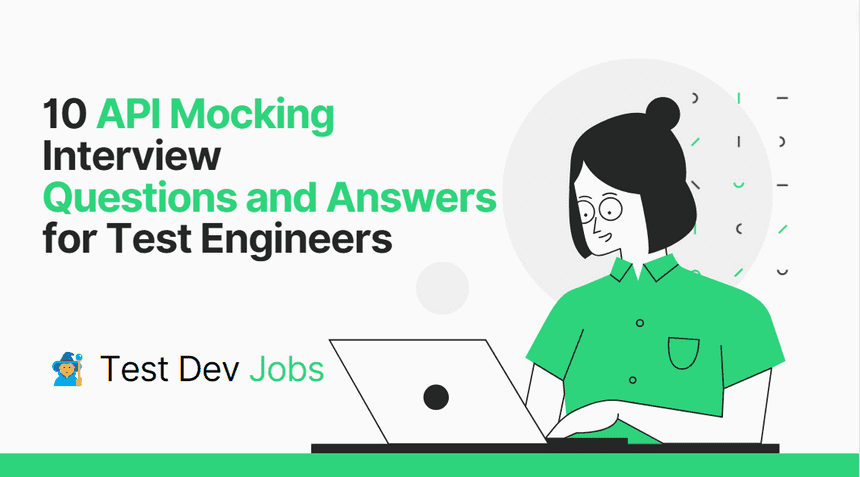
Introduction
API mocking is a crucial aspect of software development, enabling test engineers to simulate API responses for testing and development purposes. In this article, we'll explore 10 comprehensive interview questions and answers that focus specifically on API mocking.
1. What is API mocking, and why is it essential in the software development lifecycle?
API mocking involves creating simulated responses from APIs to replicate real-world scenarios without relying on actual services. It is essential in the software development lifecycle for testing components that depend on external APIs, allowing teams to work in parallel, reduce dependencies, and facilitate testing in different scenarios.
2. How does API mocking benefit test engineers, and in what scenarios would you use API mocking?
API mocking benefits test engineers by providing a controlled environment for testing, reducing the reliance on external services, and enabling early testing in the development process. Scenarios for API mocking include testing components that are still in development, validating error-handling scenarios, and conducting performance testing without affecting actual services.
3. Can you explain the difference between API mocking and stubbing?
API mocking involves creating a simulated API with predefined responses, while stubbing involves replacing specific functions or methods in the code with predetermined responses. API mocking is more holistic, simulating entire API interactions, while stubbing is more focused on individual functions or methods.
4. Share your experience with using tools for API mocking, and which ones do you find effective?
I have experience using tools like WireMock, Postman Mock Server, and MirageJS. WireMock is versatile and allows for sophisticated mocking scenarios, Postman Mock Server integrates seamlessly with the Postman ecosystem, and MirageJS is excellent for front-end development. The choice depends on project requirements and the desired level of control over the mocking process.
5. How do you handle dynamic data in API mocking scenarios, and why is it important?
Handling dynamic data involves creating mock responses that vary based on specific conditions. This is important for simulating real-world scenarios where API responses may change dynamically. Using placeholders or scripting in the mocking tool allows for the generation of dynamic data in responses.
6. Discuss the role of stateful API mocking in testing complex scenarios.
Stateful API mocking involves maintaining the state between different API calls, enabling testing of complex scenarios that depend on the sequence of interactions. This is particularly useful for testing workflows, user journeys, and scenarios where the order of API calls matters.
7. Can you demonstrate how you would simulate error responses using API mocking?
Simulating error responses involves configuring the mocking tool to respond with specific HTTP status codes and error messages. For example, using WireMock:
stubFor(get("/api/resource")
.willReturn(aResponse()
.withStatus(500)
.withBody("Internal Server Error")));
This allows testing how the system handles error scenarios gracefully.
8. How do you ensure that API mocking aligns with the actual API specifications?
Aligning API mocking with actual specifications involves regularly updating mock responses based on API documentation changes. Automated tools can help validate that mock responses conform to the documented API schema, ensuring consistency between the mock and actual services.
9. Explain the benefits of using API mocking in a continuous integration/continuous deployment (CI/CD) pipeline.
API mocking in CI/CD pipelines allows for the early validation of code changes without relying on external services. It accelerates feedback loops, ensures that changes integrate seamlessly, and prevents issues related to API changes from affecting downstream stages in the pipeline.
10. Share an example of a challenging API mocking scenario you encountered and how you addressed it.
In a scenario involving a complex microservices architecture, I needed to simulate interactions between multiple services during development. Using WireMock, I created stateful mocks that mimicked the expected behavior of each service, allowing comprehensive testing of the entire system even before all services were fully implemented.
Conclusion
API mocking is a powerful technique that enhances testing capabilities during the software development lifecycle. These 10 interview questions and answers cover various aspects of API mocking, from basic concepts to advanced scenarios. Use this knowledge to showcase your expertise in API mocking during interviews and contribute to the efficient and effective testing of software systems.
Never miss exciting Software Testing Jobs.
Join 500+ people getting weekly digest of new testing career opportunities 👇
No spam, ever. We'll never share your email address and you can opt out at any time.